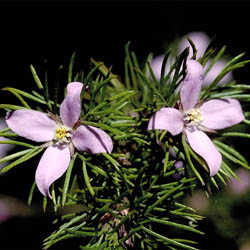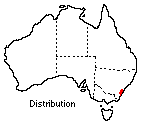Boronia subulifolia
 |
 |
This Boronia is found only in a restricted area of the Budawang Range and associated plateaus north-east of Braidwood, New South Wales. It is closely related to the better known and more widespread Boronia pilosa.

Its natural habitat ranges from low, open heath to forest. In the former situation, plants tend to be 70-80 cm high with compact habit, while in the latter they may exhibit a considerably taller, more straggly appearance in their search for light.
The star-shaped, pink flowers consisting of four petals, each 6-10 mm long, are produced singly in the leaf axils in spring from September to mid November. The soft, hairy leaves, each consisting of seven to nine tapered leaflets, are crowded along the stems.
In cultivation, with regular watering and application of fertiliser, this species tends to be more vigorous than in the wild and produces large arching branches. A well-drained sandy soil in dappled shade, maintained in a cool state by mulching or the placement of rocks around the root zone, should ensure success. Tip pruning immediately after flowering will encourage compact growth and more flowers the following year.
Plants growing in the Gardens, are about 1 m high by 1.5 m across, and are healthy, compact, vigorous shrubs which flower freely. As with other species of Boronia, propagation from soft-tip cuttings taken in summer are usually successful. Boronia subulifolia appears to be long lived, free of insect pests and diseases and is long flowering - qualities which recommend it for more widespread cultivation.
Text by Richard Nipperess, ANBG (1980)
Look here for a glossary of botanical terms.
Name meaning: Boronia subulifoliaBoronia - after Francesco Borone (1769-94), an Italian plant collector; subulifolia- a botanical-Latin compound, subuli-, from subula, awl, and folia, from folium, leaf, referring in this case to the finely pointed 'awl-shaped' leaflets. |
![An Australian Government Initiative [logo]](/images/austgovt_brown_90px.gif)

